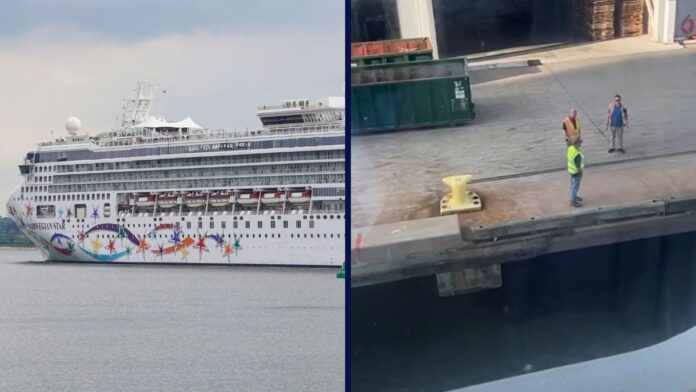Crisis averted! After losing power shortly after setting sail, Norwegian Star’s current sailing is back on track with no impact to the itinerary.
The 2001-launched cruise ship embarked on a 14-night Transatlantic sailing to Iceland from New York’s Manhattan Cruise Terminal yesterday, July 12, at 4:00 p.m. EST.
But shortly after setting sail, a power outage left the Dawn-class ship adrift in the Hudson River without air conditioning, running water, or propulsion.
Tug boats had to help the 91,740-gross ton ship back to Pier 88 in Manhattan, where thankfully, the issue was able to be resolved quickly.
“On July 12, 2025, the ship departed New York City at its scheduled departure time of 4:00 p.m. As a result of a technical propulsion issue, the captain made the decision to return to the port with the assistance from two tugboats,” a spokesperson from Norwegian Cruise Line told Cruise Hive.
“After further inspection, the issue was quickly resolved by the time the ship returned to port.“
It’s not clear what caused the issue, but the ship reportedly suffered from propulsion issues and power loss in 2003, 2004, 2005, 2006, 2015, 2016, 2017, 2018, and 2019.
Many of these incidents were related to the Azipod propulsion system that is used by several NCL ships, but it’s unclear if Azipod was the culprit this time.
“Following clearance from the United States Coast Guard, the ship departed New York City at 12:30 a.m. and is scheduled for a sea day on Sunday, July 13 before the expected arrival into Halifax, Nova Scotia, Canada on Monday, July 14,” the spokesperson’s statement continued.
Cruise tracking data confirms that the ship departed once again at 12:30 a.m. PST on the morning of July 13 and is cruising along at normal speeds to her first port call, which is on Halifax, Nova Scotia, Canada, on July 14.
This is great news for the up to 2,348 passengers onboard, who at this time, will not need to miss out on any of their planned port calls.
The exciting itinerary includes stops at Sydney, Nova Scotia, Canada; Prince Edward Island, Canada; Nuuk, Greenland; Paamiui, Greenland; Isafjordur, Iceland; Akureyri, Iceland; and Grundarfjordur, Iceland, before disembarking in Reykjavik, Iceland, on July 26, 2025.
Are Power Outages Becoming More Common?
Lately, there has been a slight uptick in news of power outages impacting cruise ships, leaving some to wonder how safe they will be on their next sailing.
Just this summer, MSC Orchestra experienced an extended power outage following a small electrical fire in June, while Celebrity Infinity was stranded in Kusadadi, Turkey, for several days in July following its own small fire and blackout.
During the 4th of July holiday, Royal Caribbean’s Harmony of the Seas also experienced an overnight power outage after minor electrical issues caused a firewall to go down.
With the Netflix “Trainwreck” documentary also bringing the infamous “Poop Cruise” onboard Carnival Triumph back into the spotlight at around the same time as these outages, some are nervous about meeting a similar fate on their next cruise.

Read Also: Are Cruises Safe? What You Really Need to Know
That said, large-scale power outages really are uncommon, especially when you consider that hundreds (if not thousands) of cruise ships are sailing around the world constantly and only a few have had notable issues as of late.
In every recent situation, the ships were able to either resolve the issue quickly or situate themselves in a port where passengers could come and go at their leisure and have access to the expected creature comforts.
The cruise lines have also grown a lot since Carnival Triumph’s 2013 poop cruise, and are prepared to spring into action should a problem arise.
First, modern cruise ships have backup generators onboard that can provide emergency power if there is a main engine failure or another type of electrical issue.
Additionally, skilled engineers are part of the crew and are onboard for every voyage to troubleshoot and start making repairs at sea when necessary.
In the unlikely event of an emergency, cruise ships have a variety of ways to contact land or other vessels for immediate assistance, including very high frequency radios, digital selective calling, and satellite communication methods.
The rollout of Starlink internet, which delivers broadband internet access using satellites in outer space, have also improved connectivity in recent years.

